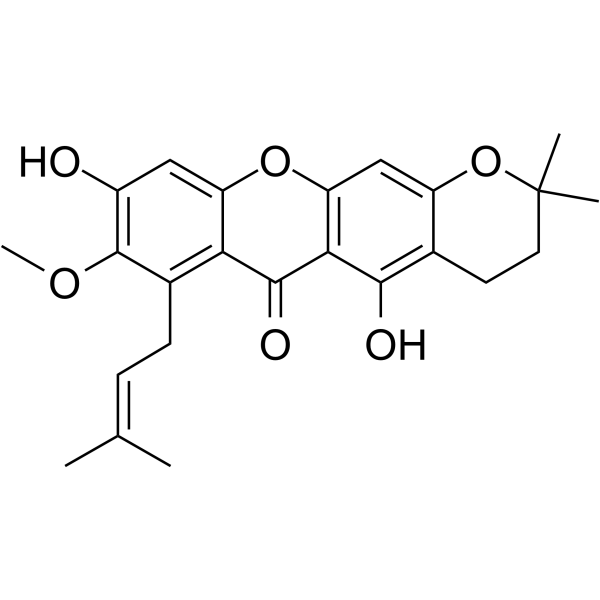
3-Isomangostin
CAS No. 19275-46-8
3-Isomangostin( —— )
Catalog No. M27955 CAS No. 19275-46-8
3-Isomangostin is an acetylcholinesterase selective inhibitor and a potent human aldose reductase inhibitor with an IC50 of 3.48 uM.
Purity : >98% (HPLC)
 COA
COA
 Datasheet
Datasheet
 HNMR
HNMR
 HPLC
HPLC
 MSDS
MSDS
 Handing Instructions
Handing Instructions
| Size | Price / USD | Stock | Quantity |
| 5MG | 300 | Get Quote |


|
| 10MG | 511 | Get Quote |


|
| 25MG | 807 | Get Quote |


|
| 50MG | 1062 | Get Quote |


|
| 100MG | 1467 | Get Quote |


|
| 200MG | Get Quote | Get Quote |


|
| 500MG | Get Quote | Get Quote |


|
| 1G | Get Quote | Get Quote |


|
Biological Information
-
Product Name3-Isomangostin
-
NoteResearch use only, not for human use.
-
Brief Description3-Isomangostin is an acetylcholinesterase selective inhibitor and a potent human aldose reductase inhibitor with an IC50 of 3.48 uM.
-
Description3-Isomangostin is an acetylcholinesterase selective inhibitor and a potent human aldose reductase inhibitor with an IC50 of 3.48 uM. 3-Isomangostin has free radical scavenging activity and inhibits MutT homolog 1 (MTH1) with an IC50 of 52 nM. It shows antiplasmodial activity with an IC50 values in the range of 4.71-11.40 uM. 3-Isomangostin can be used to develop anticancer agents as well.(In Vitro):Species of Garcinia have been used to combat malaria in traditional African and Asian medicines, including Ayurveda. In the current study, we have identified antiplasmodial benzophenone and xanthone compounds from edible Garcinia species by testing for in vitro inhibitory activity against Plasmodium falciparum. Whole fruits of Garcinia xanthochymus, G. mangostana, G. spicata, and G. livingstonei were extracted and tested for antiplasmodial activity. Garcinia xanthochymus was subjected to bioactivity-guided fractionation to identify active partitions. Purified benzophenones (1-9) and xanthones (10-18) were then screened in the plasmodial lactate dehydrogenase assay and tested for cytotoxicity against mammalian (Vero) cells. The benzophenones guttiferone E (4), isoxanthochymol (5), and guttiferone H (6), isolated from G. xanthochymus, and the xanthones α-mangostin (15), β-mangostin (16), and 3-Isomangostin (17), known from G. mangostana, showed antiplasmodial activity with an IC50 values in the range of 4.71-11.40 μM. Artemisinin and chloroquine were used as positive controls and exhibited an IC50 values in the range of 0.01-0.24 μM.
-
In Vitro——
-
In Vivo——
-
Synonyms——
-
PathwayOthers
-
TargetOther Targets
-
RecptorAntibiotic|Bacterial
-
Research Area——
-
Indication——
Chemical Information
-
CAS Number19275-46-8
-
Formula Weight410.46
-
Molecular FormulaC24H26O6
-
Purity>98% (HPLC)
-
SolubilityIn Vitro:?DMSO : 100 mg/mL (243.63 mM)
-
SMILESCC(C)(CC1)Oc(cc2Oc(cc3O)c4c(CC=C(C)C)c3OC)c1c(O)c2C4=O
-
Chemical Name——
Shipping & Storage Information
-
Storage(-20℃)
-
ShippingWith Ice Pack
-
Stability≥ 2 years
Reference
1.Bhuta P, et al. Analogues of chloramphenicol: circular dichroism spectra, inhibition of ribosomal peptidyltransferase, and possible mechanism of action. J Med Chem. 1980 Dec;23(12):1299-305.
molnova catalog



related products
-
Z-Phe-Ala-NH2
Heterocyclic Organic Compound
-
Yuanhuanin
Yuanhuanin is a natural product for research related to life sciences.
-
BAM 15
BAM 15 is an uncoupler of mitochondrial protonophore. BAM 15 is fully capable of increasing mitochondrial respiration in the presence of oligomycin and does so across a broader concentration range than FCCP in both myoblasts and hepatocytes and it is able to increase O2 consumption across a broad dosing range without increasing ROS.



 Cart
Cart
 sales@molnova.com
sales@molnova.com


